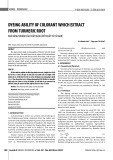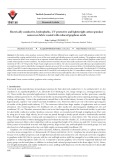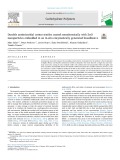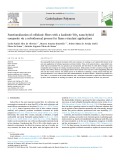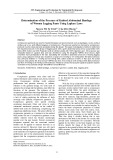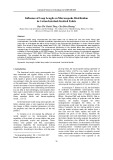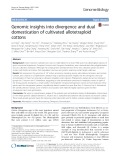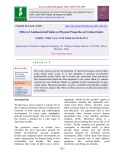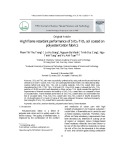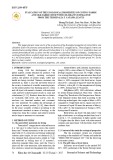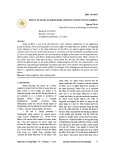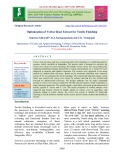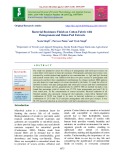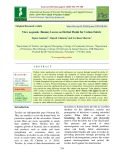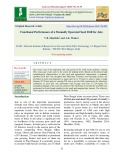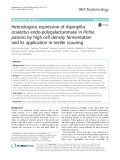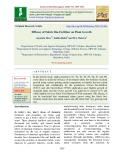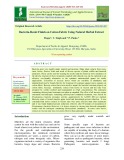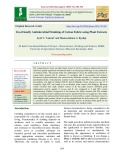
Cotton fabric
-
This paper presents study on dyeing ability of Turmeric root with silk and cotton woven fabric. The result shows that the colorant which extracted from Turmeric root can dye for both silk and cotton woven fabric, with the color fastness in grey-scale level 3-4 and 1, respectively.
 3p
3p  vimarillynhewson
vimarillynhewson
 02-01-2024
02-01-2024
 6
6
 3
3
 Download
Download
-
In this study, cotton spunlace nonwoven fabrics with four different basis weights were coated with graphene oxide (GO) by conventional dip coating method which is one of the most simple and effortless process in textile industry. The graphene oxide coated cotton nonwoven fabrics were immersed in an aqueous sodium dithionite solution in order to obtain reduced graphene oxide (RGO) coated cotton spunlace nonwoven fabrics.
 19p
19p  lyhuyenthu
lyhuyenthu
 31-01-2023
31-01-2023
 5
5
 2
2
 Download
Download
-
An important preventive measure for providing a bacteria-free environment for the patients is the introduction of highly efficient and durable antibacterial textiles in hospitals. This work describes a single step sono-enzymatic process for coating of cotton medical textiles with antibacterial ZnO nanoparticles (NPs) and gallic acid (GA) to produce biocompatible fabrics with durable antibacterial properties.
 6p
6p  vihermione
vihermione
 06-01-2023
06-01-2023
 3
3
 2
2
 Download
Download
-
Eco-responsible flame retardant treatments with some resistance to washing are of considerable interest in the sale and applications of technical garments and home textiles. Thus, in the present study, a nano-hybrid composite based on kaolinite-TiO2 was prepared and incorporated into the fibers of cotton fabric through a more sustainable route compared to existing commercial processes.
 16p
16p  viginny
viginny
 30-12-2022
30-12-2022
 10
10
 2
2
 Download
Download
-
Determination of the pressure of knitted abdominal bandage of women legging pants using laplace laws
This paper investigated a method to determine the required pressure in the design of legging pants with a given abdominal pressure by using knitted CVC fabric (60% Cotton and 40% Polyester) with all stitches plated with 100% Spandex yarn. The pressure was calculated based on Laplace laws and was checked by using the designed FSR402 force sensor.
 9p
9p  vispyker
vispyker
 16-11-2022
16-11-2022
 32
32
 4
4
 Download
Download
-
Functional textile using microcapsules has been taken lots of interest all over the world. Along with microcapsules, the textile substrate contributes important part to the performance of end use products. This study was to investigate the effect of loop length on the microcapsule distribution in cotton interlock knitted fabric.
 5p
5p  vimelindagates
vimelindagates
 18-07-2022
18-07-2022
 5
5
 3
3
 Download
Download
-
Cotton has been cultivated and used to make fabrics for at least 7000 years. Two allotetraploid species of great commercial importance, Gossypium hirsutum and Gossypium barbadense, were domesticated after polyploidization and are cultivated worldwide. Although the overall genetic diversity between these two cultivated species has been studied with limited accessions, their population structure and genetic variations remain largely unknown.
 13p
13p  vialfrednobel
vialfrednobel
 29-01-2022
29-01-2022
 12
12
 0
0
 Download
Download
-
The study focused on the development of bacterial resistant cotton fabric using lemon peels waste. It is also intended to produce eco-friendly antimicrobial cotton fabric and to protect the consumers from infections. The antimicrobial finish has been imparted to the cotton fabric by exhaust and pad dry cure methods. Finish was applied in 5g/l concentration on grey cotton fabric.
 7p
7p  trinhthamhodang11
trinhthamhodang11
 27-04-2021
27-04-2021
 10
10
 0
0
 Download
Download
-
SiO2 and TiO2 sols were successfully synthesized by using sodium silicate and titanium chloride as Si and Ti sources. SiO2-TiO2 sol coated polyester/cotton fabric was fabricated by deepcoating method and using SiO2 , TiO2 sols as coating materials. SiO2 -TiO2 coated fabric were characterized by XRD, FTIR, TGA, SEM and EDX. From SEM image, it showed the SiO2, TiO2 particles of 20-30 nm which well deposited on fabric surface. TGA result revealed the significant improvement of thermal resistance and stability of SiO2-TiO2 coated fabric as compared to those of uncoated fabric.
 8p
8p  kequaidan11
kequaidan11
 07-04-2021
07-04-2021
 17
17
 2
2
 Download
Download
-
This paper presents some results of the evaluation of the Ecological properties of cotton fabric and silk fabric dyed with colorants extracted from the Terminalia T. catappa leaves. The ecological criteria are standardized according Okotex: pH value of Cotton fabric is 6.2, of silk fabrics is 6.
 4p
4p  chauchaungayxua11
chauchaungayxua11
 23-03-2021
23-03-2021
 34
34
 6
6
 Download
Download
-
The aim of this study is to analyze the effect of three seam types, stitches (301, 401 and 504) and directions (warp, weft and 45o bias) on the drape behaviour of medium cotton woven fabrics. Drape profiles of fabrics with seams provide guidance for garment designs, producers in the apparel industry and improve the understanding of drape properties corresponding to different seam features. The results also will be useful in predicting garment drape in further study
 9p
9p  chauchaungayxua11
chauchaungayxua11
 23-03-2021
23-03-2021
 26
26
 4
4
 Download
Download
-
Vetiver root has many end uses in ayurveda and textile finishing. It is multifunctional bio resource widely available in Karnataka. The present study is designed to optimize the vetiver root extract for textile finishing. The Gulabi variety vetiver root was powdered by traditional pounding technique and powder of varied concentrations (2, 4, 6 and 8 %) were subjected to aqueous and ethanol extraction. The present investigation is focused on optimization of vetiver root extract for textile application.
 14p
14p  gaocaolon9
gaocaolon9
 22-12-2020
22-12-2020
 11
11
 2
2
 Download
Download
-
The study was planned to assess the efficacy of pomegranate and onion peel extracts on cotton fabric with respect to bacterial resistance. Pomegranate and onion peel extract were extracted by soxhlet method and applied in two concentrations i.e. 3g/l and 5g/l. Desized and scoured cotton fabric was finished with these two pure extracts of pomegranate and onion peels and their three standardized combinations by exhaust method.
 5p
5p  gaocaolon9
gaocaolon9
 22-12-2020
22-12-2020
 10
10
 1
1
 Download
Download
-
In present study Vitex negundo leave’s extract was used to assess the antibacterial activity on cotton fabric. Extraction of phytochemicals was carried out using different solvents like ethanol and aqueous. Total phenolic content (TPC) results revealed that TPC of Vitex negundo leave’s extract were highest in case of ethanolic extraction as compared to aqueous. It was observed that mild to moderate antibacterial properties were present in ethanolic extract as compared to aqueous extract. Clear zone of inhibition was observed on cotton fabric against E coli and S. aureus.
 10p
10p  caygaocaolon7
caygaocaolon7
 18-09-2020
18-09-2020
 15
15
 2
2
 Download
Download
-
In this study, we synthesized silica sol by ion exchange from sodium silicate. Silica sol solution is used for coating the surface of cotton fabrics [21, 22]. Effect of nanosilica content (through number of coating times) on fire resistance (UL-94, LOI) and mechanical properties of the materials are investigated and evaluated.
 8p
8p  nguyenxuankha_bevandan
nguyenxuankha_bevandan
 14-08-2020
14-08-2020
 18
18
 1
1
 Download
Download
-
Jute crop is one of the important cash crop grown in the south Asian countries. Among fibre crops, jute comes next to the cotton for making textile. Based on the physical and morphological characteristics of jute seed and agronomical requirement, a manually operated seed drill was designed and fabricated.
 8p
8p  chauchaungayxua5
chauchaungayxua5
 05-05-2020
05-05-2020
 15
15
 0
0
 Download
Download
-
Removal of non-cellulosic impurities from cotton fabric, known as scouring, by conventional alkaline treatment causes environmental problems and reduces physical strength of fabrics.
 9p
9p  vihamax2711
vihamax2711
 21-04-2020
21-04-2020
 8
8
 0
0
 Download
Download
-
In the present study, eight treatments (T1, T2, T3, T4, T5, T6, T7, and T8) were taken to study the efficacy of developed fabric bio-fertilizer on plant growth using various potting media components to identify the best suited component and combination for the production. Cotton bio-fertilizer (T3C3) and silk bio-fertilizer (T5S2) application gave highest growth of marigold plant and the lowest growth was achieved in control (T7) and while slightly lower in Farm Yard Manure (FYM) treatment (T8).
 15p
15p  trinhthamhodang1212
trinhthamhodang1212
 06-04-2020
06-04-2020
 14
14
 0
0
 Download
Download
-
Bacteria grow very rapidly under warmth and moisture. Many plant extracts from roots, stem, leaves, flowers, fruits and seeds of diverse species of plants exhibit anti-bacterial properties. These can be used for treating the textiles and the relatively lower incidence of the adverse reaction of these treatments coupled with reduced cost can be exploited as an effective eco-friendly alternative to the synthetic antimicrobial agents for textile applications.
 6p
6p  caygaocaolon4
caygaocaolon4
 04-04-2020
04-04-2020
 16
16
 1
1
 Download
Download
-
The comprehensive focus on plant based extract in textile coating as antimicrobial textile finish has gained significant momentum and is an emerging technology in the production of medical cloths. The present study was undertaken to assess the antibacterial activity of cotton fabric treated with E. globulus, T. cordifolia and T. procumbens leaf extracts. Extraction of phytochemicals was carried out by different solvents viz., ethanol, methanol and distilled water.
 9p
9p  cothumenhmong4
cothumenhmong4
 25-03-2020
25-03-2020
 8
8
 0
0
 Download
Download
CHỦ ĐỀ BẠN MUỐN TÌM









